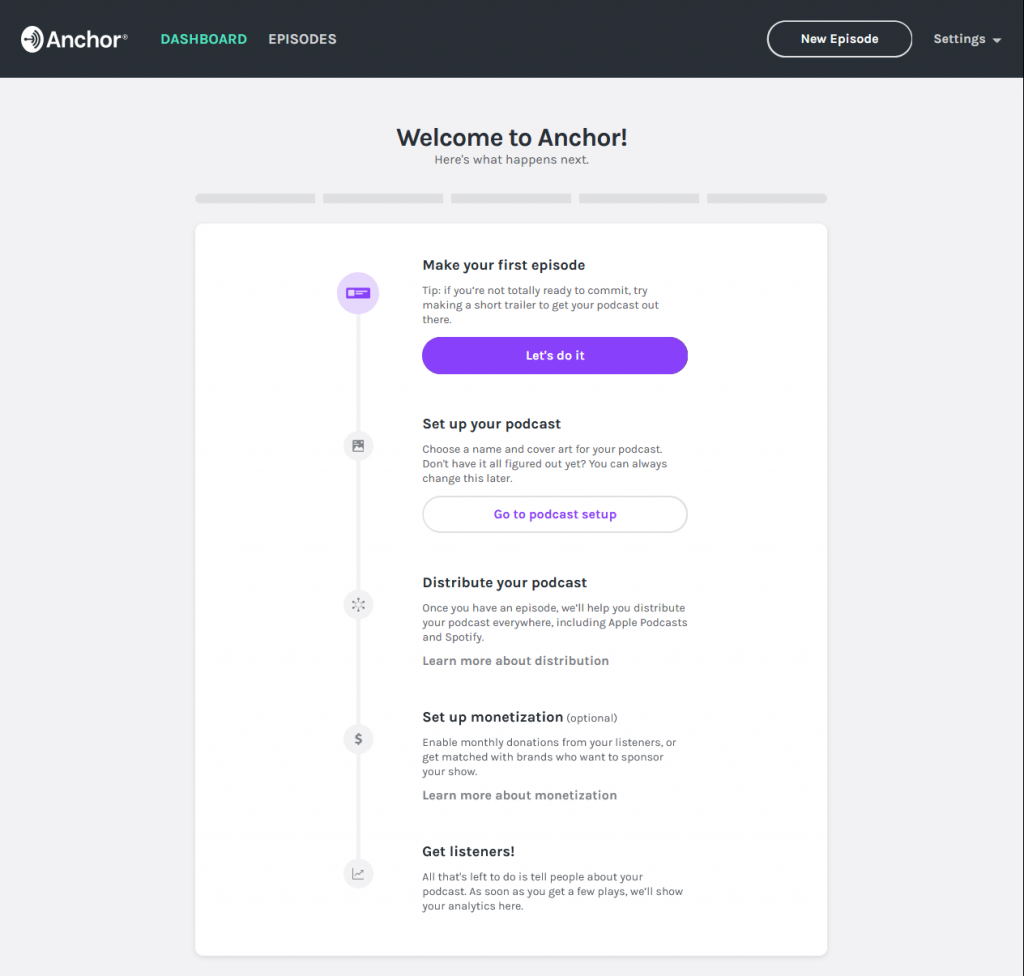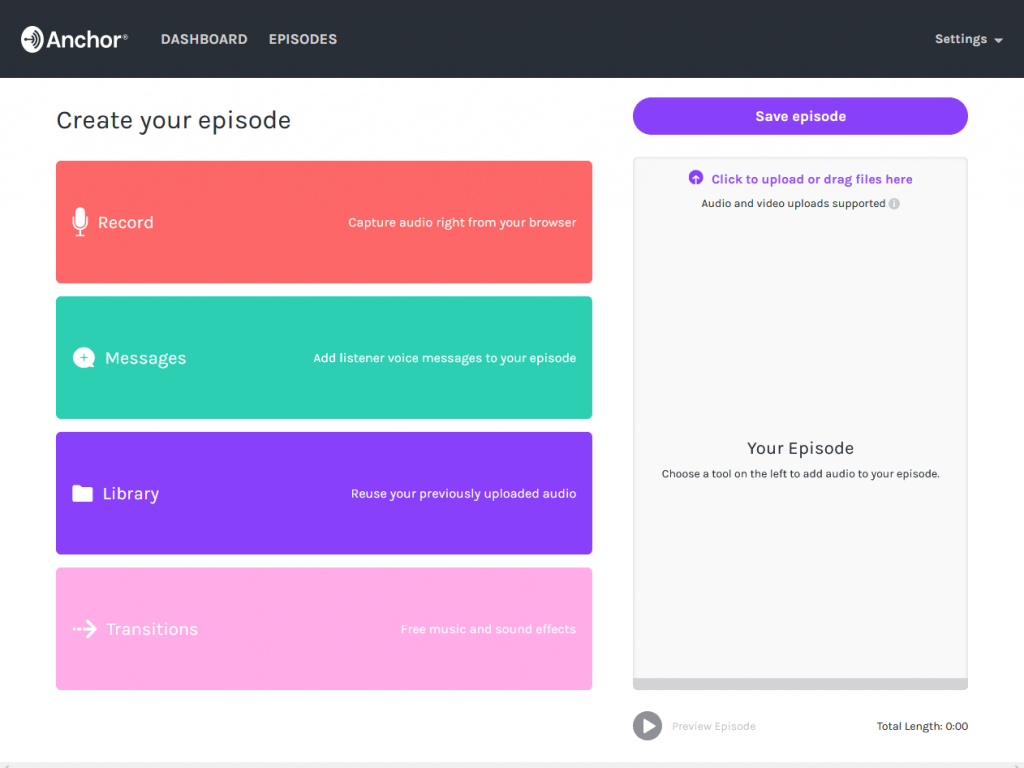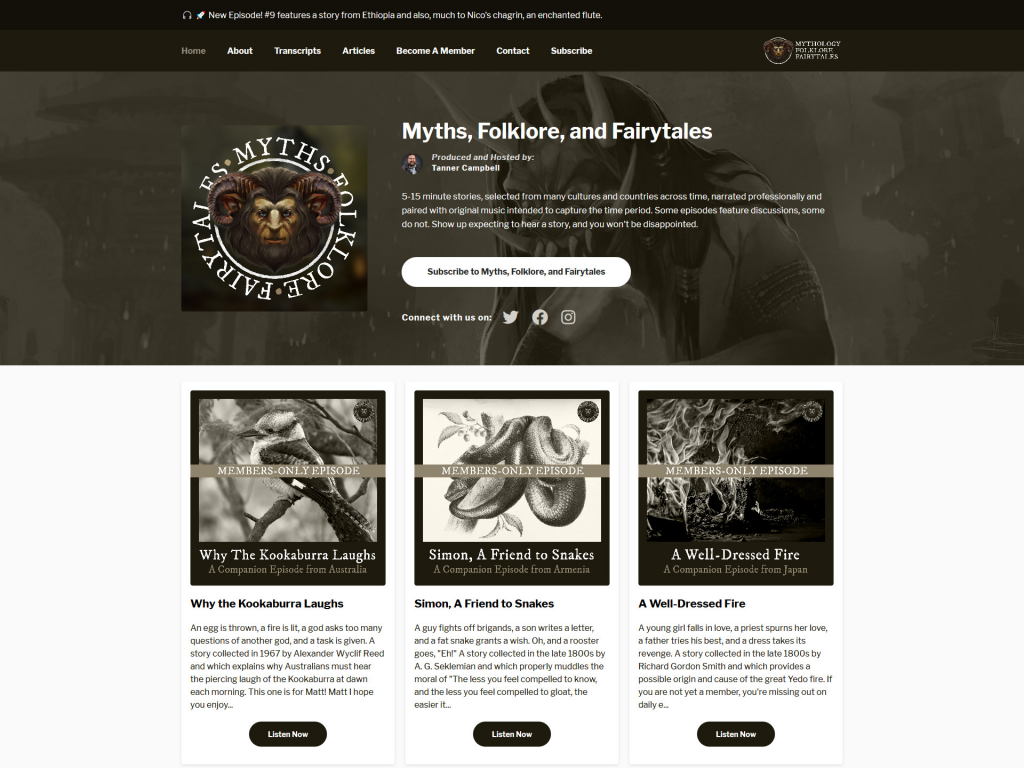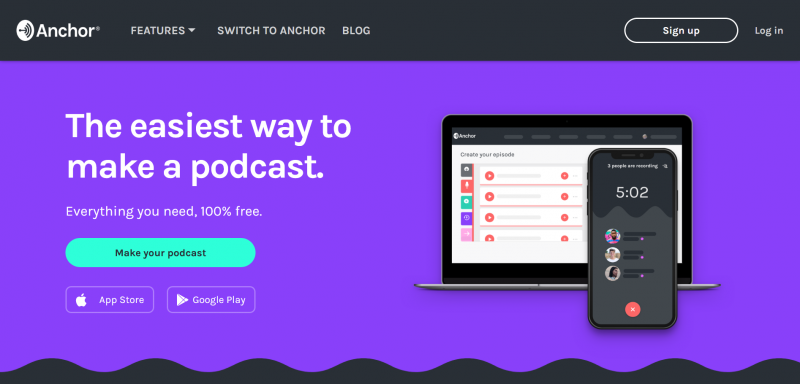Anchor.fm is the most popular podcast host. It is completely free, and backed (owned) by Spotify. If you’ve just decided to start a podcast, Anchor.fm might be a great solution for you to start with. It helps lowering the entry barriers and anyone with a simple smartphone can start their own podcast with Anchor. In this article, we’ll review Anchor.fm and their offering. We’ll then go through the process of staring a new podcast with Anchor, and give you everything you need to know to start a podcast.
What is a podcast?
As you may already know, a podcast is a recorded audio program that can be consumed online (or downloaded). Usually, listeners can use popular platforms like Apple Podcasts, Spotify, Google Podcasts and the likes to find and listen to podcasts. Anyone can start a podcast, and while it’s recommended to get some basic equipment like a microphone, it’s not fully required.
A podcast is usually “hosted” by one or several persons, who discuss any topic they might choose. There are various types of podcasts, ranging from daily news all the way to niche topics like true crime, business, comedy or audio dramas. Many podcasts bring guest interviewees, and expand their reach and the topics they can cover that way.
Everyone can start a podcast today. You don’t need a whole lot to start one, and that’s the main reason we see more and more new podcasts released each and every year.
Creating a podcast with Anchor – A step by step guide
While you can just record an episode without any preparation, and release a 2-hour non-stop recording, it’s not really recommended. Usually, podcasters tend to keep their episodes short (20-40 minutes). There’s no real limit, but remember that your listeners must have a lot of patience if you plan to talk for a couple of hours.
There are so many podcasts (more than a million), and according to various statistics people usually listen to about 7 podcast shows a week. The competition on attention is quite high, so you need to invest as much as you can and make your podcast sound right, interesting and unique enough. So let’s dive right into the process of creating a podcast with Anchor.fm –
1. Pre recording – Plan everything!
Pick a topic
Your podcast should be consistent – listeners are usually looking for a specific topic or genre, unless they get a personal recommendation from someone else. If each episode is completely different than the previous one, it will be hard to get the same audience to return and follow the show.
Pick a topic that you love and can talk about for hours. It could be a niche, like video games, cooking, technology, startups, true crime, or it can be fiction/drama etc. It’s really up to you to decide what you want to talk about, but we do recommend to plan it in advance.
Try to see what other podcasts are already talking around the same topic, and think about ways to make yours unique. Planning each episode is important, as you want to jump from segment to segment within each episode without wasting too much time talking about the same things.
Choose your format
As said above, planning is key to keep your podcast relevant.
How long do you want to run each episode?
Do you want/need to have a co-host (or more than one co-host) with you to cover the podcast topics?
Want to bring outside guests on a regular basis?
There are some podcasts that are producing their podcasts in seasons. Each season might be covering a completely different story (like Serial or In the Dark), and some just make it in seasons to make it more structured.
Choose a name
Now that you know the topic, genre and format, it’s probably the time to pick a name. There are a few guidelines that could help you:
- The name – it should either be descriptive, or really creative – something that will get people to try your podcast. If you already have a brand name for you or your company, add that to the podcast name.
- The background check – you should check that the name is not being used already. Search in the podcast directories or on search engines. If you are going to also use social media to promote the podcast, you might want to see that the handle is available (or at least a similar handle, but make sure that the original handle you wanted is not being used by another podcaster).
Try not to pick a generic name like “Coffee Podcast” as there could be dozens of podcasts with the same name. A good name would also be unique when people search for it on search engines.
Buy a microphone
Sound quality is very important. People would just stop listening if there’s bad sound quality, or a terrible background noise when you record your show. While you don’t have to buy a microphone to start a podcast with Anchor.fm (as you can record directly from your smartphone), it’s recommended to get at least a cheap microphone to get decent sound quality.
There are many low-end microphones that can be great to start with. The Podcast Host reviewed many microphones – you can check the review and decide for yourself.
2. Podcasting with Anchor – Recording, editing and hosting
Now that you are ready to podcast, and already picked the name, the format, and have the recording tools, it’s time to really record!
Anchor lets you record directly to the platform. So the first step will be to create an account with Anchor. The initial screen is a welcome screen which takes you through the process, step by step.

The first action is making your first episode. You can either record straight from this screen, or upload previously recorded episode (or episodes). It doesn’t have to be a single long recording. You can break the episode into sections, add and arrange the files in the order you want. There is also an option to add music tracks (intro, outro, or any other transition you’re looking to make).
So start by adding an intro. Make sure to explain what this podcast is about, and what the listeners should expect going forward.

Once you’re done, click on the save episode button. It will take you to the episode settings screen. Here you should add the episode title, episode description, art image, and more. You should also decide if you want to publish the episode now or in a future time.

Finally, you’ll need to fill out the information about your podcast. It includes the podcast name, description, category and language. There’s also an option to create your podcast cover art (or you could upload one if you already prepared it with a different tool).
3. Anchor podcasts – Distribution
You’ll need to distribute your podcast if you want listeners to find it. Anchor will let you do it manually, or automatically for you.
What does it mean to distribute your podcast? There are many podcast directories and apps that people use in order to search and listen to podcasts.
You just need to add your podcast RSS feed to those platforms and then your podcast will appear there. The apps and directories that Anchor connects with are Spotify, Castbox, Breaker, Apple Podcasts, Google Podcasts, Overcast, RadioPublic and Pocket Casts.
4. Promoting your podcast with Anchor
Great, so your podcast is ready and is live – Congratulations!
If you already hit publish and distributed it to the familiar apps, you might wonder what’s next? How do you get people to actually find and listen to your podcast?
Anchor can automatically create a “mini-site” for you with your podcast. It includes the episodes, your social media links, and subscribe buttons. While it’s nice to have as it’s free and does not require any additional work from you, it’s simply not enough to get new listeners.
It’s recommended to create a full website for your podcast (meaning, a website that includes your episodes, description, pages, blog posts, a store, and more). You can create a website with WordPress, Squarespace, Wix, or Podcastpage.io. We wrote a guide that explains how to create a Podcastpage website for your Anchor podcast.
Once you have a website that contains your episodes, show notes, and blog posts, it will start to rank on search engines.
Additionally, you should look at creating audiograms – those short video clips that contain a snippet from your podcast, with subtitles and audio wave. They are shareable and help gain some attention on social media platforms. Read more here about the different tools that could help you create them.

Is Anchor the right solution for me?
Anchor.fm is really a great solution for your first podcasts or if you’re on a strict budget. With that said, there are a few downsides we must include in this review –
- Anchor creates a basic feed for you. However, you don’t have much flexibility around it. Many other podcast hosts would give you a more advanced episode form with way more inputs, so you can really add more details to your podcast RSS feed.
- The Anchor.fm website has no domains, no custom pages, no blog section, and you cannot even change the branding. If you share your Anchor.fm website, it will promote them more than promoting your own brand or podcast. We believe it’s critical that you use your own domain on your own website.
- Control over your podcast – Anchor submits the podcast for you on various channels and directories. As an example, if you don’t submit your own podcast from your own Apple account to Apple Podcasts, you may not get access to the podcast statistics.
- Control over the audio – Anchor automatically processes the audio you upload, and so it may be subpar when comparing to podcasts that are hosted elsewhere.
Is Anchor free for life? How does that work?
Anchor is completely free. It is owned by Spotify, so they do have a strong company that can back them up financially. With that said, we never know if they would start, say, to plug ads or promote Spotify or their product range on your own podcast without a possibility to control it.
This is currently a non-issue for most users, but it’s something to keep in mind.
Conclusion – creating a podcast with Anchor
Anchor.fm makes it very easy to create a podcast! It’s free to use, and includes many features. There’s nothing stopping you from dipping your toes and just trying out.
Once you’re all in, don’t forget to create a dedicated website, add content, and share video clips. When you start to get some traffic, you can use the analytics Anchor is offering, alongside other analytics tools for your website, to get a complete picture.
We recommend to create a dedicated podcast website right from the get-go, and have more control over your podcast content and brand.
Podcastpage.io integrates perfectly with Anchor.fm, allowing you to import your feed automatically and import the Anchor audio embed player.



